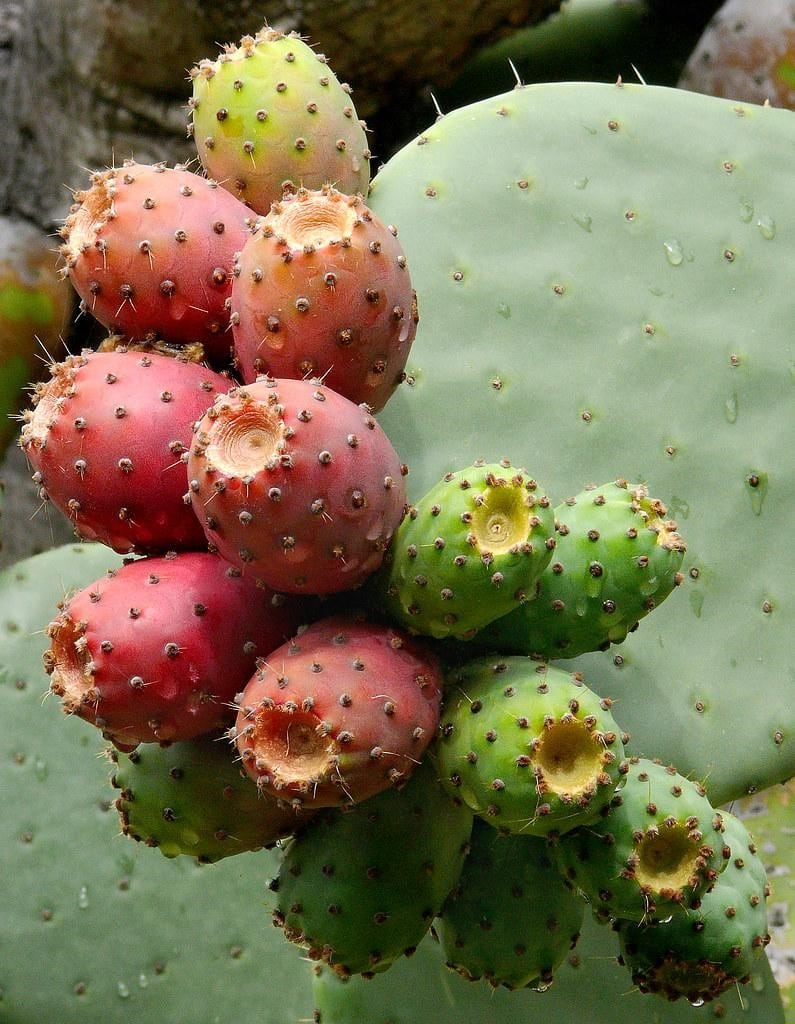Before climate change took center stage in the environmental consciousness of the world, activists and diplomats already fretted about the growing risk of desertification—agricultural lands becoming degraded to the point where they essentially become desert. Overgrazing and unsustainable farming practices are seeing large swaths of Africa’s Sahel swallowed by the Sahara. Desertification also affects developed countries such as Australia, but it threatens smallholder farmers and pastoralists the most.
In 1993, fears of crippling desertification inspired the creation of CactusNet, the first international collaborative effort to promote the farming of cactus species. CactusNet proposed helping arid-land farmers fight desertification by taking advantage of one of the deserts’ most helpful inventions: succulent, hardy, and fruit-bearing prickly pear cactus. The idea is now being resurrected in the face of worsening climate change.
Why cactus? This author has encountered plenty of cactus plants during his time in Arizona and can assure you that they look nothing like anything you might want to eat. But folks at the International Center for Agricultural Research in Dry Areas, or ICARDA, know better. Point of fact, some species of cactus are highly edible for both humans and domesticated animals. “With its high water efficiency and content, cactus can sustain livestock through the driest of seasons,” ICARDA points out in a policy brief.
You can eat nearly every part of the edible prickly pear cactus plant, including the spiny green frond, or cladode, and the slightly less spiny but colorful fruit. What this plant lacks in visual appeal and texture (the spines exist both to collect water and to prick you as a defensive mechanism) is more than made up for in health benefits. The fruit of Opuntia, the genus of edible prickly pears, is rich in antioxidants, vitamins, protein, fiber, and amino acids. ICARDA says cactus pear boasts low acidity while packing a lot of sugar, thus vital energy for humans and animals alike. Meanwhile, eating the cladode will not only provide you with moisture but also calcium, protein, and carbohydrates.
“Integrating cactus into dryland farming systems and rangelands under changing climate can be one plausible solution.”
The Aztecs were one of the first peoples to discover the nutritional and medicinal properties of wild prickly pear cactus, and today cactus is often considered a delicacy in Mexican cuisine. Cactus cultivation and consumption could be key to protecting smallholder farmers from climate change-induced droughts—and desertification. Cattle could get through dry spells by consuming more water-rich cactus, while farmers could cushion themselves from drought-induced crop failures by diversifying into a crop evolved to thrive in ultra-low water environments. At least, that’s the idea floated by CactusNet.
A prickly solution
In recent years, governments, university researchers, and ICARDA scientists have been stepping up efforts to establish and expand cactus cultivation in North Africa, India, and arid portions of Latin America. In a 2019 study published in the journal Sustainability, a team of Indian scientists touted cactus farming as a powerful way to help adapt India’s farms to global warming. “Integrating cactus into dryland farming systems and rangelands under changing climate can be one plausible solution to build resilient agro-ecosystems that provide food and fodder,” they wrote (https://www.mdpi.com/2071-1050/11/21/5897).
A literature review published last year by Pakistani scholars argues that expanding prickly pear cactus farming is not only desirable but increasingly necessary. But for this to happen, further agricultural innovation is in order. Despite its climate-resilient properties, “a variety of impediments hampering its wide-scale cultivation” must be overcome, the team said. Thus prickly pear cactus “demands a comprehensive genetic improvement and agronomic technology package” (https://www.scielo.br/j/pd/a/x3HWfNfGSpDsvC8T4JZbJkS/?format=pdf&lang=en).
In other words, science needs to build a better cactus.
Better breeds, better acceptance
The dangerous spines or needles are an obvious issue, but that’s been taken care of—spineless varieties of agricultural prickly pear cactus exist. However, there are other issues. The plant can be relatively slow-growing and low-yielding. At the same time, some farmers are concerned that it could spread out of control as a noxious weed, choking out other crops. Cattle can’t simply graze on cactus, needles or no, because it’s a perennial with growing points not adapted to grazing. For now, the fruits and cladodes must be carefully cultivated, processed (you have to cut the outer husk of the fruit away to get to the edible part), and chopped up so that animals may more easily feed on them–all labor-intensive. A study out of South Africa also found that cattle fed with a mixture of cactus and traditional feed gained less weight than a control group. A number of innovations around yield, plant structure, and animal nutrition are needed before widespread adoption.
Cultivating cactus to help smallholder farmers and pastoralists fight global warming. It’s an interesting concept: If you can’t beat the desert, join it. Grow Further is looking at innovations to make cactus better up to the task.
— Grow Further
Photo credit: Prickly pear cactus fruit. James Gaither, Creative Commons.




